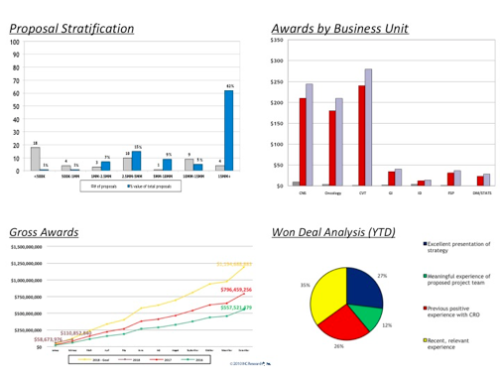What has your CRM done for you lately?
October 15, 2019 | Ty Quinn |
Industry Articles
Guest post by Ty Quinn (CRO Business Development Executive):
The Contract Research Organization (CRO) sector is complex. Business Development professionals are required to maintain accurate and organized records of any/all accounts, contacts, interactions and opportunities and to be able to call on them at a moment’s notice. As a Manager of teams spanning countless time zones, I needed a platform that enabled me to have ready access to my teams’ activities and opportunity pipeline. As a member of Executive Management teams, driving strategy was only possible through actionable data.
An effective Contact Relationship Management system (CRM) is a meaningful solution to the above-referenced challenges. However, simply purchasing licenses will not do anything more than hit your organization’s bottom line. Make the platform work for you, and instill in your team an understanding of the value that a more organized approach can bring to their daily sales efforts. To do this:
- Give your team ownership and help them generate reports and output that they themselves will value
- Assess what is/isn’t working on a continual basis
- With consensus, implement change and keep guidance documentation up to date
One of the most valuable lessons that I learned in working with a CRM was that it should be dynamic and modified based upon the evolution of the environment in which it is deployed.
One of the biggest challenges that I faced was Business Developers complaining of the “administrative burden” of logging everything in the CRM. I confronted this argument by highlighting the ability to better organize one’s efforts, something that I had done with great success, and the importance of my having ready access to their data. I used the, “God forbid you are hit by a bus…” example to help them understand that we could never afford to have a customer’s information reside within an individual’s cranium alone!
Consistent data leads to reports people will value
Despite the ‘hit by a bus’ conversations, and there were many, I had to implement measures to ensure that the discipline I had requested was easy for the team to achieve. My goal was to create a culture in which this process became rote. I reassessed every field and section within the system to ensure that we were capturing the details we needed to and that key information would be required to be entered before anything could be saved. These requirements enabled me to work with the team to generate reports on their own activities/pipeline as well as to create aggregate reports to share within our organization.

As we began using these reports, it became evident to me that naming conventions of activities and opportunities would ease the review of summary information within the system. I worked with the team to develop conventions that made sense for us and could provide a reader with a snapshot of the activity/opportunity:
Sample activity naming convention:
Email – Novartis – Follow-up on Tourette’s Proposal
Sample opportunity naming convention:
Oncology – Phase III – NSCLC
As a result of these efforts, we became smarter, more efficient and more effective Business Developers.
Create a user guide for your team and keep it up to date
An organized and well-functioning CRM enabled me to become a more efficient manager. Not only was I now equipped with meaningful data to share with my CEO and Operations colleagues but I had more time to focus helping the team grow and close business. I was no longer chasing information, as it was all a button-push away. I used some of this newfound time to create a CRM user guide detailing system utilization and best practices. The user-guide became a resource for existing employees and was invaluable in the onboarding process. It ensured that the team maintained a level of consistency in our approach to Business Development and CRM utilization.
Aim to set up your CRM in a way that lets you understand your wins and losses
From the Executive Management perspective, our CRM drove our growth strategy. We had visibility into the types of business we were winning, why we were winning, why we were losing and insights into future growth opportunities (therapeutic, geographic and service). It also gave us visibility into our own performance metrics and in doing so, opened our eyes to the benefits of broadening the scope of our use. We worked with functional area leaders to create user profiles (a measure to ensure data integrity), dedicated sections and specific fields. The more we used it, the better it became and our company benefitted from remarkable year-on-year growth.
Whether its Salesforce, Dynamics, Sugar or any others, a CRM is like any other data system: you get out of it what you put in to it. Through the implementation of some of the concepts embedded herein:
- Users can become more efficient and effective in the management of their accounts, opportunities and communication
- Managers will be better in the day-to-day oversight of their teams
- Executives will have ready access to data enabling strategic growth decisions
So tell me…how are you going to put your CRM to work for your contract research organization today?
--

Ty Quinn has been an executive in the Contract Research Organization (CRO) sector since 1999. He led team efforts from an individual contributor perspective and spent 10+ years leading high performing teams, achieving over $2.5B in sales. Ty attributes his success to an aptitude for building and maintaining high performing teams and an unwavering commitment to collaboration with operational team members. In serving on the Executive Management teams of several CRO’s, Ty has been actively engaged in merger and acquisition activities and strategic growth initiatives. He is a firm believer in the disciplined collection and utilization of data in decision-making. Ty currently provides insights and guidance to organizations in the clinical research sector (CRO, Venture Capital, Private Equity, ancillary services, etc.).





.png?width=500&name=Q3%202024%20Biopharma%20Recap%20(Zymewire).png)

Comments